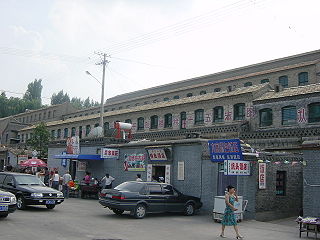This page is based on this
Wikipedia article Text is available under the
CC BY-SA 4.0 license; additional terms may apply.
Images, videos and audio are available under their respective licenses.

The Blang people are an ethnic group. They form one of the 56 ethnic groups officially recognized by the People's Republic of China.

The Palaung or Ta'ang are a Mon–Khmer ethnic minority found in Shan State of Burma, Yunnan Province of China and Northern Thailand. In China, they are referred to as the De'ang people.

Dazhai is a village and former commune of several hundred farmers in Xiyang County in eastern Shanxi province, chiefly known for Mao Zedong's directive, "Learn from Dazhai in agriculture", which set up Dazhai as the model for agricultural production throughout China during the 1960s and 1970s, amid the Cultural Revolution.
The "Learn from Dazhai in agriculture" Campaign was a campaign organized by Mao Zedong in 1963. The campaign encouraged peasants from all over China to follow from the example of the farmers of Dazhai village, Shanxi, by practicing self-sacrifice and upright political activity.

Lancang Lahu Autonomous County is an autonomous county under the jurisdiction of Pu'er City, in southwestern Yunnan province, China. Lancang is the same as Lan Xang, and refers to the Mekong River on its eastern borders and adopted by modern Laos, a Tai word meaning Million Elephants.

Shidian County is under the administration of the [[prefecture-level city of Baoshan, in the west of Yunnan province, China. Its seat is the town of Dianyang (甸阳镇).

Yun County or Yunxian is a county in the west of Yunnan province, China. It is the easternmost county-level division of the prefecture-level city of Lincang.

Xinping Yi and Dai Autonomous County is an autonomous county located in the central part of Yunnan Province, China. It is the westernmost county-level division of the prefecture-level city of Yuxi.

Jinping Miao, Yao, and Dai Autonomous County is located in Honghe Hani and Yi Autonomous Prefecture, Yunnan province, China, bordering Vietnam's Lai Châu Province to the south. Jinping is home to the Red-headed Yao (红头瑶族) minority group who wear a pointed red hat on their heads after they get married.

Hua County or Huaxian is a county under the administration of Anyang City, in the north of Henan province, China.

Longsheng Pan-Ethnicities Autonomous County is a county in the northeast of Guangxi, China, bordering Hunan province to the north. It is under the administration of Guilin city.

Lingshou County is a county in the west of Hebei province, China. It is under the administration of the Shijiazhuang city. Lingshou town is located in the southeastern portion of Lingshou County. The location of Lingshou town is approximately 38.309646 N, 114.382275 E.
Jinping County is a county in the east of Guizhou province, China. It is under the administration of the Qiandongnan Miao and Dong Autonomous Prefecture.
The Bolyu language is an Austroasiatic language of the Pakanic branch. The Bolyu are among the unrecognized ethnic groups of China. In 1984, Bolyu was first studied by Liang Min of the Nationalities Research Institute in Beijing. Liang was the first to suggest the Mon–Khmer affiliation of Bolyu, which was later confirmed by Western linguists such as Paul K. Benedict, Paul Sidwell, and Jerold A. Edmondson.
Dazhai or Tachai (大寨) is a village in Shanxi made famous in the "Learn from Dazhai in agriculture" campaign.
Va is a pair of Angkuic languages spoken in Mojiang Hani Autonomous County, Yunnan, China. Although the Va autonym is, the language is not Wa, and neither does it belong to the Waic language subgroup. Rather, Va constitutes a separate subdivision within the Angkuic languages.

The Longjia are an unofficially recognized ethnic group of western Guizhou province, China. They are officially classified as Bai by the Chinese government.
The Hani languages are a group of closely related but distinct languages of the Loloish (Yi) branch of the Tibeto-Burman linguistic group. They are also referred to as the Hanoid languages by Lama (2012) and as the Akoid languages by Bradley (2007).
Suobi 梭比 is a Southern Loloish language of south-central Yunnan, China. It is documented in Bai (2010). Suobi is closely related to Haoni.
Hezhang Buyi or Shui is an endangered, divergent Northern Tai language spoken in Hezhang County, Guizhou, China. It has a Kra substratum. Like other Kra languages, Maza, and Tujia, Hezhang Buyi displays circumfixal negation. Hezhang Buyi was only discovered in 2013.














